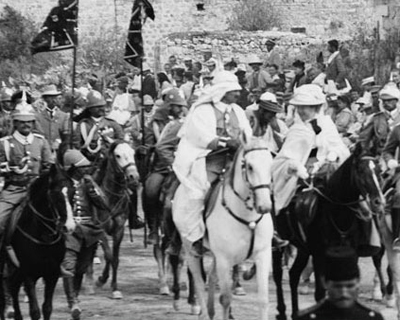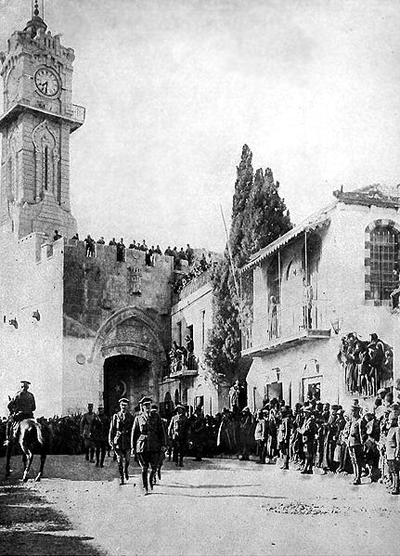Haaretz has the following report about another planned underground tunnel in the Jewish Quarter of the Old City in Jerusalem:
A wide-ranging plan for renovation of parts of the Old City of Jerusalem envisions a new gate being broken in the city walls for the first time in 112 years.
The plan, prepared by architect David Shriki as part of a greater plan for renovation of the Western Wall area drawn up by architect Gavriel Kertesz, was presented Tuesday to the municipal Planning and Building Committee and aims to renovate the Jewish Quarter and in particular ease access to the Western Wall Plaza.
The new gate will be an entry to a tunnel that would be hewn through the rock under all the layers of the city, beginning between Zion Gate and Dung Gate, leading to a four-story parking garage under the current parking lot not far from the Western Wall. The planners said both tunnel and garage will be hewn in rock deep beneath the city, leaving its numerous archaeological layers intact.
The last time a new opening was breached in the city walls was in 1898, when Ottoman authorities destroyed part of the wall near Jaffa Gate. The purpose was to allow the passage of the imperial carriage of Germany’s Kaiser Wilhelm II, who was then visiting the city.
This time, the plan is meant to accommodate the tens of thousands of visitors to the Western Wall, as well as residents of the Jewish Quarter. The parking garage would hold 600 cars, planners said.
The main technical obstacle to the plan is its high cost, raised by the need to cut through solid rock, estimated at hundreds of millions shekels. Some of the budget is meant to come from using the current outdoor parking lot for construction. Both this aspect of the plan and the proposed tunnel and garage have drawn protests from both Muslim religious figures and residents of the Jewish Quarter.
The planning committee did not vote on the plan and will continue discussing it over the coming week.
This plan would certainly reduce the congestion in this area. The report, however, contains several inaccuracies. First of all, the wall near the Jaffa Gate was not breached in 1898. Kaiser Wilhelm II wanted to enter the Old City riding on his white horse and to make that possible, only the moat between the Jaffa Gate and the Citadel was filled in.

By contrast the much humbler General Allenby entered the city on foot in 1917.

Secondly, if this tunnel is to be cut through solid rock “under all the layers of the city”, then it must go below the Turkish city walls as well, which would therefore not be breached. It is to be hoped that the planners know where the top of the rock layers are located, for the preserved remains of the entrance to the Byzantine Nea Church are buried some 3-4 m. below the present parking lot.
Source: Joe Lauer

Are you sure about the Jaffa Gate? Every other source I’ve read says that the the wall was breached between Jaffa Gate and David’s Citadel to allow the kaiser’s entourage to enter the city — ie, it was not just a question of filling in the moat.
James, see my reply in the latest blog post.
Thank you for this post. Actually, the “myth” of the Kaiser’s request is even more complex: Prof. Dr. Dr. Alex Carmel, probably one of the best informed experts on German history in the Holy Land, writes on this: “Die Franzosen, Russen und Engländer betrachteten freilich mit Neid die enorme Popularität, die der Kaiser unter den Türken und der einheimischen Bevölkerung Palästinas genoß und sparten nicht an Kritik und mit Spott. So verbreiteten sie die (völlig erfundene) Behauptung, daß
der Kaiser den Sultan veranlaßt hätte, die alten Mauern von Jerusalem
aufzubrechen, um in die Stadt hoch zu Roß hineinreiten zu können.” (“The French, the Russians and the English noted with envy the enormous popularity of the Kaiser among the Turks and the local populatian of palestine, and they responded with criticism and ridicule. The spread the (entirely fictional) claim that the emperor had caused the sultan to break down the walls of Jaffa geat to enable his entrance on horseback”, http://www.gda.bayern.de/ausstell/palaestina/Broschuere.pdf page 16).
I am sure this can be documented even better in the relevant sources and literature, however I do not have time and means at the moment to go deeper into this. In a lecture presented at the Augusta Victoria Centre in Jerusalem a few years ago, I heard another historian’s report about the matter (I don’t have names and sources available): According to his presentation, it was the wish of the Turkish sultan Abd el Hamid II to display the well-developed state of the city to his royal visitors and strategic allies, and therefore to enable their triumphal entrance through Jaffa gate. The Kaiser, upon being informed by letter about the sultan’s plans, added a handwritten note on the margin of the letter: “what a stupid idea!”.
Guido,
Thank you for that. The fictional claim is still believed by some people today!
(This comment replaces my earlier comment. I found the appropriate sources. If you find it helpful to add anything from my previous post, please do so.)
Thank you for this post (and for many others on this valuable site). However, concerning the visit of the “Kaiser” to Jerusalem, the myth of the “breach of the wall” is even more complex than indicated here. As Prof. Dr. Dr. Alex Carmel, probably the most learned authority on the history of Germans in the Holy Land, has pointed out in several publications, it was neither at the Kaiser’s request nor with with his consent that the Jaffa gate entrance was paved in preparation for his visit. Actually, the records in the archives of the German ministry of foreign affaiurs reveal that the Kaiser, upon receiving a written report about the plans to remove parts of the structures around Jaffa gate, added a handwritten comment on the margin of the report: “This must be inhibited! I hope such an act of barbarism will not be carried out!” (Political archives of the ministry of foreign affairs (PAAA), Bonn: Prussia, record 1/4v, Vol. 5). These details (and others) about the visit can be found in the very extensive documentation of the Kaiser’s journey by Alex Carmel and Jacob Ejal Eisler: “Der Kaiser reist ins Heilige Land” (1999), page 51 ff.
Thanks again – most informative and interesting.